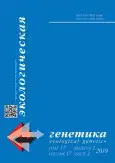Role of the interaction of resistance genes to acaricides of different chemical classes in the posterity of diheterozygous females of the two-spotted spider mite
- Authors: Sundukov O.V.1, Tulaeva I.A.1
-
Affiliations:
- All-Russia Institute of Plant Protection
- Issue: Vol 17, No 2 (2019)
- Pages: 63-68
- Section: Genetic toxicology
- URL: https://journals.rcsi.science/ecolgenet/article/view/10266
- DOI: https://doi.org/10.17816/ecogen17263-68
- ID: 10266
Cite item
Abstract
Background. Information on the change in the correlation of genotypes in arthropod populations after treatment of crops with pesticides is essential for effective insectoacaricide resistance management.
Materials and methods. Lines of two-spotted mite the homozygous for the gene of resistance to malathion, bifenthrin, bromopropylate and abamectin were obtained by disruptive selection cycles with treatments diagnostic concentrations of these acaricides. Crossing mites were produced heterozygous females with genes of resistance to malation and one of the other three acaricides, as well as families of their filial generation. Females of the three genotypes were compared the value of the degree resistance when testing mites by diagnostic concentrations of acaricides.
Results. Combinations of distribution of alleles of resistance to acaricides of different chemical classes in mites of the filial generation of diheterozygous females did not determine the differences from the parent females in the degree of mortality.
Conclusion. Epistatic interaction of alleles of resistance to toxicants of different chemical classes allows be used only two insectoacaricides in turn for resistance management.
Full Text
##article.viewOnOriginalSite##About the authors
Oleg V. Sundukov
All-Russia Institute of Plant Protection
Email: zubanov63@rambler.ru
Candidate of Biology, Senior Researcher
Russian Federation, 3, shosse Podbelskogo, St.-Petrsburg, Pushkin,196608Irina A. Tulaeva
All-Russia Institute of Plant Protection
Author for correspondence.
Email: tulaevaia-vizr@mail.ru
Candidate of Biology, Researcher
Russian Federation, 3, shosse Podbelskogo, St.-Petrsburg, Pushkin,196608References
- Sparks TC, Nauen R. IRAC: Mode of action classification and insecticide resistance management. Pestic Biochem Physiol. 2015;121:122-128. https://doi.org/10.1016/j.pestbp.2014.11.014.
- Сундуков О.В., Тулаева И.А., Зубанов Е.А. Эпистатическое взаимодействие генов резистентности к акарицидам у межлинейных гибридов обыкновенного паутинного клеща // Экологическая генетика. – 2016. – Т. 14. – № 1. – С. 27–33. [Sundukov OV, Tulaeva IA, Zubanov EA. Epistatic interaction of resistance genes to acaricides in interline hybrids of two-spotted spider mite. Ecological genetics. 2016;14(1):27-33. (In Russ.)]. https://doi.org/10.17816/ecogen14127-33.
- Урбах В.Ю. Биометрические методы. – М.: Наука, 1964. [Urbah VY. Biometricheskie metody. Moscow: Nauka; 1964. (In Russ.)]
- Oku K. Males of the two-spotted spider mite attempt to copulate with mated females: effects of double mating on fitness of either sex. Exp Appl Acarol. 2010;50(2):107-113. https://doi.org/10.1007/s10493-009-9306-7.
- Oku K, van den Beuken TPG. Male behavioural plasticity depends on maternal mating status in the two-spotted spider mite. Exp Appl Acarol. 2017;71(4): 319-327. https://doi.org/10.1007/s10493-017-0127-9.
- Сундуков О.В., Тулаева И.А., Зубанов Е.А. Проявление признаков резистентности к инсектоакарицидам в инбредных линиях обыкновенного паутинного клеща при дизруптивном отборе // Экологическая генетика. – 2015. – Т. 13. – № 3. – С. 76–84. [Sundukov OV, Tulaeva IA, Zubanov EA. Manifestations of resistance to acaricides in inbred lines of two-spotted spider mite in the process of disruptive selection. Ecological genetics. 2015;13(3): 76-84. (In Russ.)]. https://doi.org/10.17816/ecogen13376-84.
- Сундуков О.В., Тулаева И.А., Зубанов Е.А. Физиологический механизм эпистатического взаимодействия генов резистентности к инсектоакарицидам различных химических классов у межлинейных гибридов обыкновенного паутинного клеща // Экологическая генетика. – 2017. – Т. 15. – № 2. – С. 21–27. [Sundukov OV, Tulaeva IA, Zubanov EA. Physiological mechanism epistatic interaction of resistance genes to acaricides of various chemical classes in the interline hybrids of two-spotted spider mite. Ecological genetics. 2017;15(2): 21-27. (In Russ.)]. https://doi.org/10.17816/ecogen15244-49.
Supplementary files









